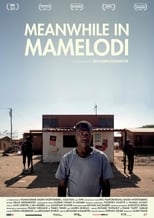During the month the 2010 World Cup is played in South Africa, Director Benjamin Kahlmeyer shows the life that goes on, meanwhile, in the impoverished township of Mamelodi. The township is only 16 miles from Loftus Stadium, but residents’ interaction is mostly limited to buying noisy vuvuzuelas and enjoying Bafana Bafana’s games on small black and white TVs.
Meanwhile in Mamelodi follows Steven Mtsweni and his family. Mtsweni is a typical township entrepreneur, running a neighborhood convenience store, or tuck shop. His life is a treadmill of hard work as he runs the family business and cares for his sons, a teenage daughter, and a mentally ill wife. He also employs 2 nephews. The family lives in a pair of corrugated metal shacks as well as in the tuck shop.
Mosquito, the daughter, plays street soccer with the neighborhood boys, as well as some organized girls soccer. Born after apartheid ended, her generation is seen as the hope for change. If she can stay focused on school, perhaps she can move up to a better life.
An ethnographic study of poverty
An ethnographic study for his student thesis, Kahlmeyer aims to capture real life in the shadow of a WC stadium. Mtsweni would love to sell to tourists, but he is prevented from selling within 3 blocks of where the tourists would be. Like most tuck shops, his business consists of selling his small inventory in even smaller units that township people can afford, such as a few cigarettes at a time. His daughter has confidence but seems unguided. The film simply ends when the tournament ends.
A post-film youtube video appealed for donations because after Mtsweni’s car broke down, he lost his tuck shop. The film’s Facebook page indicates that 5 years after filming, the family was still in the same shacks, but the daughter was now a mother. The cycle of poverty seems to remain unbroken, and another generation has been lost. As Mohlomi Maubane wrote in 2013:
“the World Cup was dangled as a carrot to the poor, as a beacon of hope and the answer to their material hardships. Now that the tournament has come and gone, it is clear that millions of people still struggle to make ends meet.”
– Mohlomi Maubane
Only FIFA really profited from WC 2010
Various studies in 2012 and 2014 have shown that WC 2010 cost South Africa $3-6 billion, but made a profit of perhaps only $100 million. There was a period of national pride, transportation infrastructure improved, hotels were built, and tourism increased. But South Africa was also left with large stadiums that have fallen into disuse, and the wide-spread corruption that is FIFA is now well-known.
FIFA was in fact the biggest beneficiary of South Africa’s world cup, taking over $3 billion back to Switzerland. You have to question, would the family’s life have been better if South Africa had spent its billions on its people, instead of hosting a one month party. For other film on the trail of poverty that FIFA leaves behind, see March of the White Elephants.
While the film has a good purpose, it is very slow and I can only recommend it to viewers who enjoy ethnographic studies.
5 Soccer Movie Mom Rating = 5
Resources:
- Released: 2011 (Germany)
- In English and African languages with English subtitles
- IMDB
- Director: Benjamin Kahlmeyer
- Stars: The Steven Mtsweni Family
- Watch the Trailer
- Facebook page

